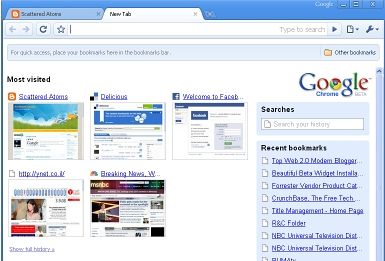 If you haven't yet had a chance to try Google's new browser Chrome, here are a few observations on the latest in the browser wars.
If you haven't yet had a chance to try Google's new browser Chrome, here are a few observations on the latest in the browser wars.Chrome's power lies in its simplicity. Expectations run high when Google announces a new browser and some of the criticism I have read is in the fact that there are no revolutionary features here. However, bells and whistles are not what Google set out to accomplish with Chrome.
Brian Rakowski, product manager for Chrome and Pam Greene, a software engineer on the team take users on a tour of the vision behind Chrome in an illustrated comic-style book online. "Today, most of what we use the web for on day-to-day basis aren't just web pages. They are APPLICATIONS. People are watching and uploading videos, chatting with each other, playing web-based games...all these things that didn't exist when the first browsers were created."
The project's primary goal was to create a stable browser (I hate a browser crash in the middle of writing a lengthy blog entry like this one). Each tab runs in its own memory space so a browser crash in one tab does not affect the others. With the advent of AJAX technologies which offers asynchronous communication over a single-threaded browser platform, Chrome's development team created a completely new browser architecture: multiple processes running in separate spaces. One process renders Javascript, another handles Java, and yet another manages visual rendering.

Here are some of its cool features, and they didn't take any digging to find out. The browser just did what I naturally expected it to do:
- Chrome, the application, loads instantaneously.
- Pages load really fast! I visit a newspaper site from Israel which is very heavy to load (http://ynet.co.il) on a daily basis. Chrome took 0.3 seconds to load the page compared to 7.609s in IE. Test it yourself with the Load Time Stopwatch.
- When I dragged a tab out of the browser, it opened a new window. Love it! This lets me compare two tabs to each other or review information in one while typing in another.
- When you right click on an image you can immediately copy the image URL to your pasteboard (exists in Firefox et. al. but in IE you need to look at the image properties to get that).
- When you load Chrome or open a new window, the window image snapshots of your recent sites are displayed. In IE7 or Firefox you need to press Ctrl-Q (or another key combination) to see this temporarily. Very helpful to revisit a recent site.
- Incognito mode lets you view pages without leaving any traces on the local desktop (cookies, favorites, history).
- History opens as a standard browser tab.
- Downloads occur at the bottom of the page with no annoying download manager window. Once its done you can drag the file from the Chrome window to your desktop or other location, open it or open the containing folder.
- Chrome's "inspect element" replaces the traditional source view with a smart, context sensitive code viewer. Power users, web developers and site "hackers" will love this feature:

Cons:
- Funny, but Google's own site, Blogger, is having minor difficulties. Particularly the HTML editor where I edit my posts. Images can not be dragged within an article and auto-complete of post labels doesn't seem to work (if you blog on Blogger you know what I mean)
- The search function doesn't seem to work in Blogger's editor
A visitor commented about facebook compatibility issues with Chrome. I noticed a few bugs in support for facebook in the original release (for instance links don't work if they have a "web 2.0" dialog that pops up).
That has been fixed - make sure you have the most recent version of Chrome by clicking on the tools wrench (to the right of the address bar): if there is a new version of Chrome you will see a notification at the bottom of the window.
1 comment:
Facebook doesn't work, either.
Post a Comment